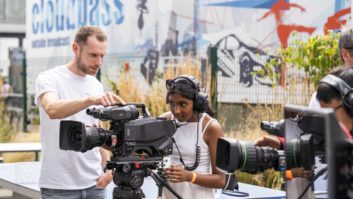RTL’s n-tv news television centre in Cologne has become one of the first customers for a new robotic camera system, RoboKam, developed by Robotics Technology Leaders GmbH and debuted at IBC.
Incorporating both face-tracking and object-tracking, the new system is controllable from a standard PC. Three RoboKam systems have been sold for use at n-tv and further trials are now in progress.
“We were asked by the German broadcaster RTL if we could make a really versatile robotic system for the n-tv news television centre in Cologne,” explained RTL CEO, Dr. Stefan Riesner. “Existing commercial systems lacked the features and repeatability RTL required. They were also expensive and in some cases too noisy for use in a live television studio. RoboKam is based on a high-precision robot mechanism which is available worldwide.”
RoboKam is designed for live or automated control of film and HD or SD television cameras. It can readily be combined with a pan/tilt unit for fixed or mobile operation modes, including virtual studio applications. Multiple RoboKams can be programmed to execute a coordinated sequence of movements with fully-automated switching between cameras.
RoboKam may be used with robotic arm mechanisms of varying size, dependent on the required load capacity, speed, working space and noise level. Complete 6D camera movement can be achieved within a spatial precision of 0.05 mm and a temporal accuracy of 4 to 16ms, enabling frame-accurate synchronisation. The operator is warned automatically if a requested trajectory will lead to a collision with another object in the studio environment or with the robotic arm itself.
The system ships with a full motion-control package including an intuitive user interface allowing recording images to be viewed in realtime. A limitless number of camera positions can be stored and then combined to create motion along multiple trajectories. Realtime live control can be achieved using joystick-like input devices such as 3DConnexion’s SpaceBall. It can be operated from a fixed base, on rails, on freely steerable wheels or overhead. Face-tracking and object-tracking can both be offset by a predefined amount to match a producer’s specific image composition. The tracking system employs two cameras (vertical and lateral) and does not require a performer to wear a tracking sensor.





